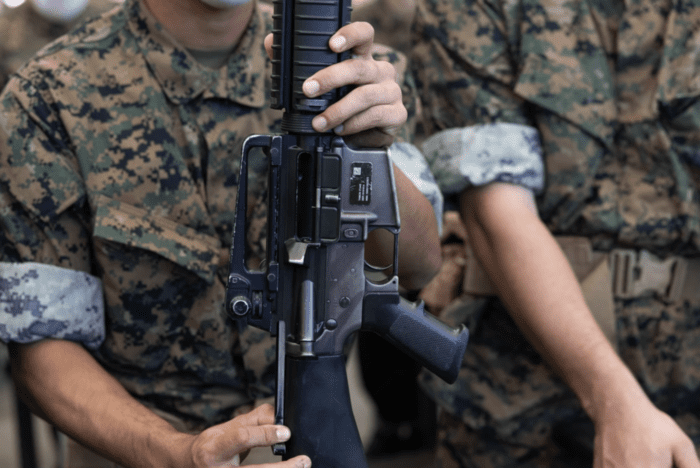Guns That Changed History: The M16 Rifle

The M16 rifle is more than just a tool of war—it’s a symbol of innovation, resilience and tactical supremacy. For more than 60 years, this rifle has played a pivotal role in shaping modern military conflicts, proving its worth on battlefields from Vietnam to the Middle East. In this article, we’ll dive into the history, evolution and lasting impact of the M16, revealing why it remains a cornerstone of military arsenals worldwide.
You’ll not only discover the origins and design advancements that set the M16 apart but also gain insight into its real-world performance from the perspective of a Marine Corps infantryman. Whether you’re a military enthusiast, a firearms collector or someone intrigued by how guns change the course of history, this article offers an in-depth exploration of a rifle that forever altered the landscape of modern warfare.
The Birth of a Legend: From AR-15 to M16
Working with Armalite in 1956, Eugene Stoner designed the AR-15, which later evolved into the M16. Initially, the M16 faced significant challenges in gaining acceptance within the U.S. military. The Army Material Command initially rejected it in favor of the M14, but an investigation found that the tests were biased. Despite this, the U.S. Air Force adopted the rifle in 1962, followed by the rest of the military.
However, the M16’s introduction to the Vietnam War was fraught with problems. Soldiers were incorrectly informed that the rifle didn’t need cleaning, and no cleaning kits were provided. The wrong propellant was also used in the 5.56mm ammunition, leading to reliability issues. Despite these early setbacks, the M16 quickly proved its worth on the battlefield, thanks to its lightweight design, accuracy and firepower.
A Rifle Built for Adaptability and Success
One of the M16’s greatest strengths is its adaptability. Since its original design, the rifle has undergone numerous upgrades, each improving its performance and versatility. The M16A2, introduced in the 1980s, brought key advancements, such as a heavier barrel for increased accuracy and durability. This version also included improved iron sights and firing modes, allowing soldiers to use semi-automatic and burst fire.
The M16A4, which followed in the late 1990s, introduced a modular rail system, allowing soldiers to attach optics, lasers and other accessories. These advancements made the rifle more customizable for various combat scenarios, ensuring it remained relevant in the ever-evolving landscape of modern warfare.
The M16’s modularity has stood out as a key feature throughout its lifespan. It was easily adapted into shorter, more compact versions like the M4 carbine and other variants used by special forces. These updates, including the ability to integrate advanced technologies, made the M16 one of the most flexible weapons in military service.
The M16’s Impact in Combat
The M16’s battlefield performance is one of the reasons it has remained a mainstay in the U.S. military for over six decades. Its use of the 5.56mm cartridge, which is lightweight yet highly effective, allowed soldiers to carry more ammunition, providing a distinct tactical advantage.
Furthermore, the M16’s direct impingement operating system contributed to its reliability, making it a go-to weapon in diverse environments, from the jungles of Vietnam to the deserts of the Middle East.
Another testament to its design is the rifle’s adaptability to different combat roles. For example, the Mk 12, a designated marksman’s rifle, was developed from the M16’s base design. Whether in standard infantry roles or specialized operations, the M16 has consistently delivered the firepower, accuracy and reliability required by modern soldiers.
My Experience with the M16-A2 in the Marine Corps
My introduction to the M16-A2 rifle took place at Marine Corps Recruit Depot, Parris Island, during the 13-week boot camp. Early training focused on mastering the weapon’s mechanics—disassembly, cleaning and reassembly—before we were allowed to engage in live fire exercises. As part of our nightly routine, we recited the Marine Rifle Creed, emphasizing our reliance on the rifle and its significance.
Qualifying with the M16-A2 was no easy task. We were required to engage targets at distances of 200, 300 and 500 yards, which was especially challenging using only iron sights. The front sight post would cover the target at that distance, forcing us to rely heavily on DOPE (Data on Previous Engagements) and trust in our training.
Following boot camp, I was issued the M16-A2 as a service rifle. I used that rifle almost every day of the week for training, weapons maintenance or inspections.
That rifle accompanied me on training exercises from the jungles of Okinawa to the Negev Desert in Israel and everywhere in between. No matter the environment, that rifle performed. Take care of your gear, and it will take care of you.
The enhancements in the A2 model, such as the improved barrel and iron sights, were crucial in ensuring we could hit targets consistently at long ranges. These experiences cemented the M16-A2 as a reliable and effective tool in my military career.
Controversies and Competitors: Why the M16 Endures
Over the years, multiple attempts have been made to replace the M16 with newer rifles. The U.S. military explored options such as the SCAR Mk 16, Stoner 63 and, more recently, the SIG Spear as part of the Next Generation Squad Weapon program.
While some of these rifles offered minor improvements, none have been able to fully replace the M16 due to the logistical challenges and cost implications of transitioning to an entirely new rifle system.
One of the most notable rivals to the M16 is the SCAR Mk 16, which performed well in tests but failed to surpass the M4—a shortened variant of the M16—used by U.S. forces. Even in special operations units, where soldiers could choose, the M4 was the preferred weapon. The consistent choice of the M4 over other rifles further highlights the M16’s enduring capabilities.
Evolution and Legacy: The End of an Era?
Although the M16 has served the U.S. military for decades, its gradual replacement has begun. The U.S. Marine Corps has started using the H&K M27 Infantry Automatic Rifle (IAR) for combat arms forces, while the Army has selected the SIG Spear as part of its modernization efforts. However, the M16 will continue to serve in support roles for the foreseeable future.
The M16’s influence on modern firearms cannot be overstated. Many of the design principles introduced by Stoner—modularity, accuracy and adaptability—are present in today’s cutting-edge rifles. Even as the military adopts new technology, the M16’s legacy lives on, both in its direct successors and in the wider development of military firearms.
Conclusion: A Rifle That Defined an Era
The M16 rifle is more than just a weapon; it symbolizes innovation and resilience. From its early struggles during the Vietnam War to its evolution into a highly modular and adaptable platform, the M16 has cemented its place in military history. Its longevity is a testament to its effective design and battlefield performance, proving time and again that it is a rifle built to last. As it slowly phases out of frontline service, its legacy will continue to influence future generations of firearms, both in the military and civilian worlds.
The M16 remains one of the most influential rifles ever made, and its impact will be felt for years to come.
Read the full article here





